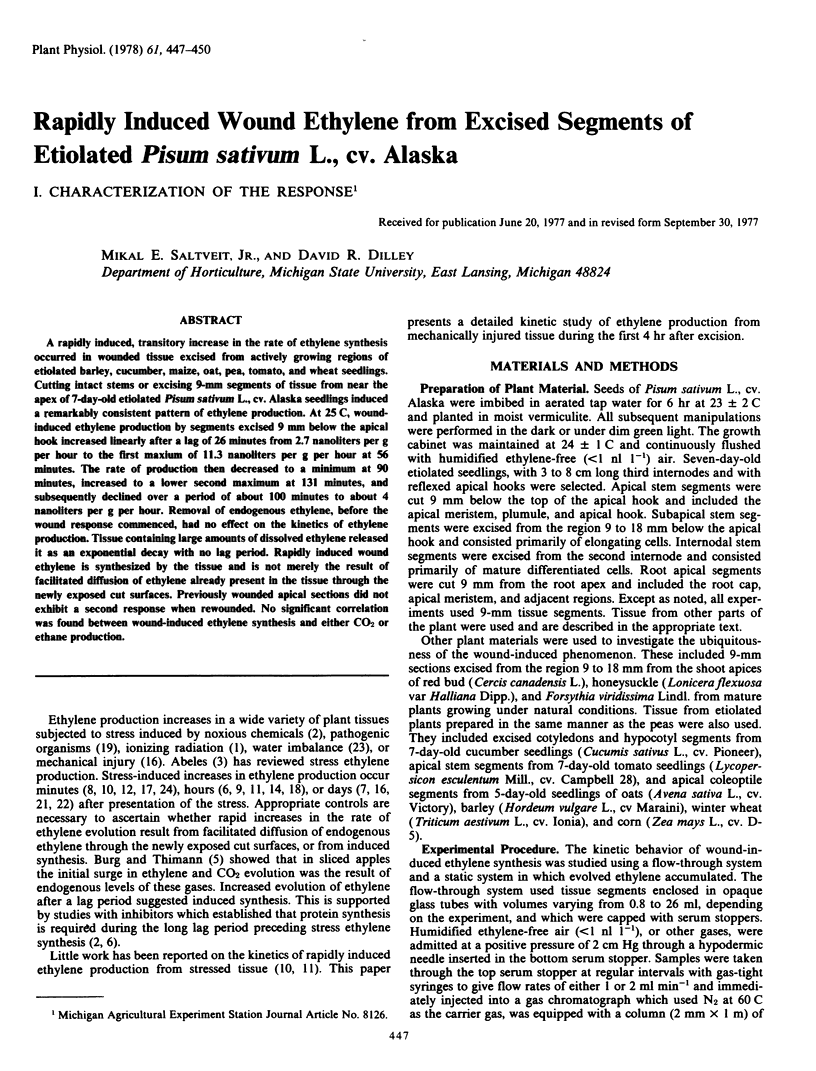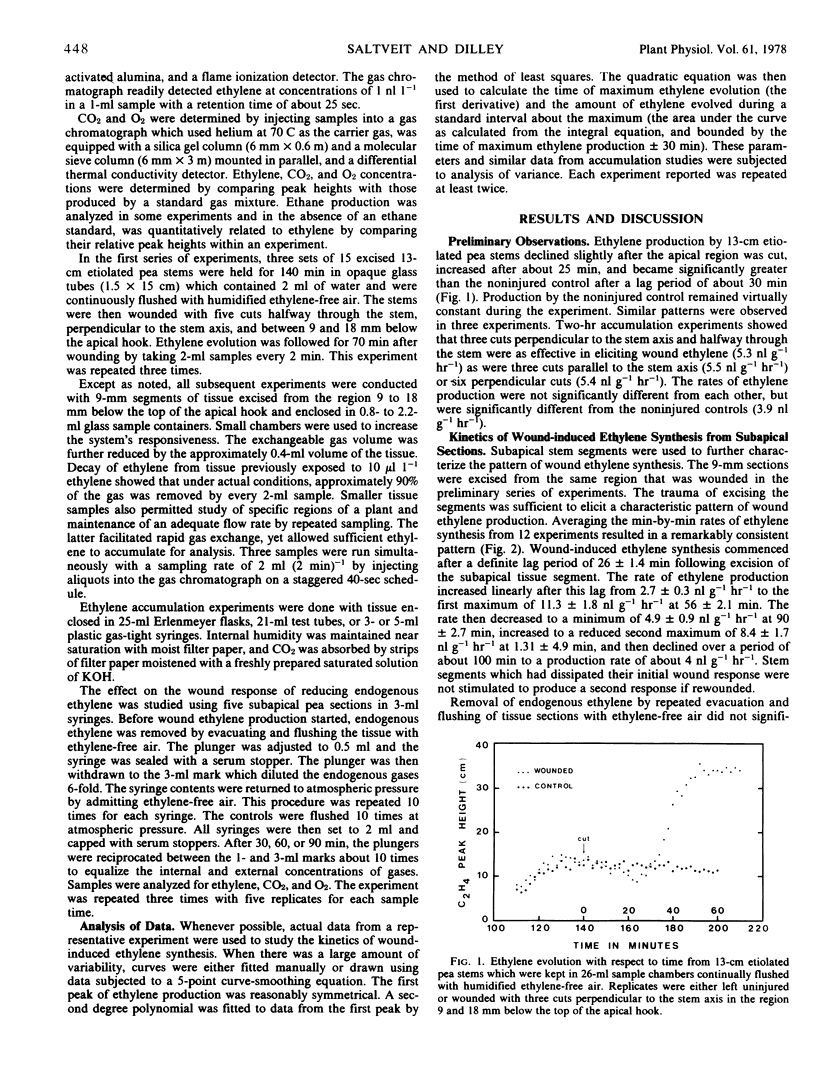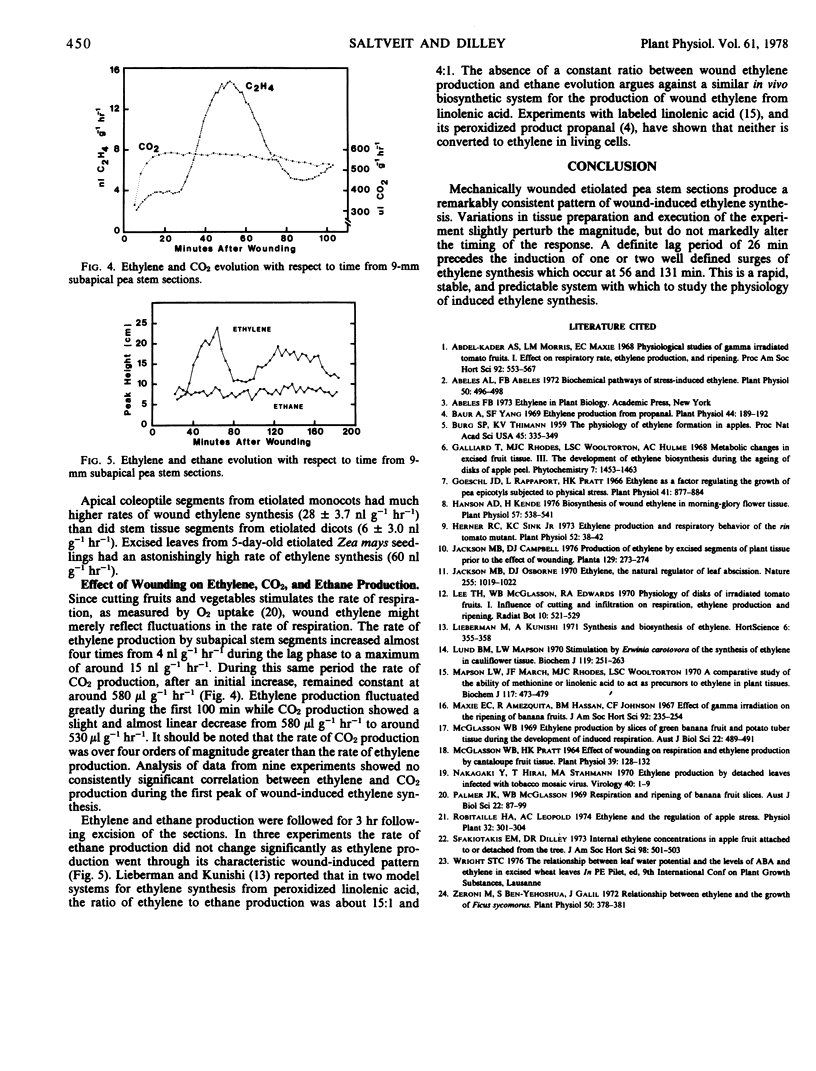Abstract
A rapidly induced, transitory increase in the rate of ethylene synthesis occurred in wounded tissue excised from actively growing regions of etiolated barley, cucumber, maize, oat, pea, tomato, and wheat seedlings. Cutting intact stems or excising 9-mm segments of tissue from near the apex of 7-day-old etiolated Pisum sativum L., cv. Alaska seedlings induced a remarkably consistent pattern of ethylene production. At 25 C, wound-induced ethylene production by segments excised 9 mm below the apical hook increased linearly after a lag of 26 minutes from 2.7 nanoliters per g per hour to the first maxium of 11.3 nanoliters per g per hour at 56 minutes. The rate of production then decreased to a minimum at 90 minutes, increased to a lower second maximum at 131 minutes, and subsequently declined over a period of about 100 minutes to about 4 nanoliters per g per hour. Removal of endogenous ethylene, before the wound response commenced, had no effect on the kinetics of ethylene production. Tissue containing large amounts of dissolved ethylene released it as an exponential decay with no lag period. Rapidly induced wound ethylene is synthesized by the tissue and is not merely the result of facilitated diffusion of ethylene already present in the tissue through the newly exposed cut surfaces. Previously wounded apical sections did not exhibit a second response when rewounded. No significant correlation was found between wound-induced ethylene synthesis and either CO2 or ethane production.
Full text
PDF



Selected References
These references are in PubMed. This may not be the complete list of references from this article.
- Abeles A. L. Biochemical Pathway of Stress-induced Ethylene. Plant Physiol. 1972 Oct;50(4):496–498. doi: 10.1104/pp.50.4.496. [DOI] [PMC free article] [PubMed] [Google Scholar]
- Baur A., Yang S. F. Ethylene production from propanal. Plant Physiol. 1969 Feb;44(2):189–192. doi: 10.1104/pp.44.2.189. [DOI] [PMC free article] [PubMed] [Google Scholar]
- Burg S. P., Thimann K. V. THE PHYSIOLOGY OF ETHYLENE FORMATION IN APPLES. Proc Natl Acad Sci U S A. 1959 Mar;45(3):335–344. doi: 10.1073/pnas.45.3.335. [DOI] [PMC free article] [PubMed] [Google Scholar]
- Goeschl J. D., Rappaport L., Pratt H. K. Ethylene as a factor regulating the growth of pea epicotyls subjected to physical stress. Plant Physiol. 1966 May;41(5):877–884. doi: 10.1104/pp.41.5.877. [DOI] [PMC free article] [PubMed] [Google Scholar]
- Hanson A. D., Kende H. Biosynthesis of wound ethylene in morning-glory flower tissue. Plant Physiol. 1976 Apr;57(4):538–541. doi: 10.1104/pp.57.4.538. [DOI] [PMC free article] [PubMed] [Google Scholar]
- Jackson M. B., Osborne D. J. Ethylene, the natural regulator of leaf abscission. Nature. 1970 Mar 14;225(5237):1019–1022. doi: 10.1038/2251019a0. [DOI] [PubMed] [Google Scholar]
- Lund B. M., Mapson L. W. Stimulation by Erwinia carotovora of the synthesis of ethylene in cauliflower tissue. Biochem J. 1970 Sep;119(2):251–263. doi: 10.1042/bj1190251. [DOI] [PMC free article] [PubMed] [Google Scholar]
- Mapson L. W., March J. F., Rhodes M. J., Wooltorton L. S. A comparative study of the ability of methionine or linolenic acid to act as precursors of ethylene in plant tissues. Biochem J. 1970 Apr;117(3):473–479. doi: 10.1042/bj1170473. [DOI] [PMC free article] [PubMed] [Google Scholar]
- McGlasson W. B., Pratt H. K. Effects of Wounding on Respiration and Ethylene Production by Cantaloupe Fruit Tissue. Plant Physiol. 1964 Jan;39(1):128–132. doi: 10.1104/pp.39.1.128. [DOI] [PMC free article] [PubMed] [Google Scholar]
- Nakagaki Y., Hirai T., Stahmann M. A. Ethylene production by detached leaves infected with tobacco mosaic virus. Virology. 1970 Jan;40(1):1–9. doi: 10.1016/0042-6822(70)90372-7. [DOI] [PubMed] [Google Scholar]
- Zeroni M., Ben-Yehoshua S., Galil J. Relationship between Ethylene and the Growth of Ficus sycomorus. Plant Physiol. 1972 Sep;50(3):378–381. doi: 10.1104/pp.50.3.378. [DOI] [PMC free article] [PubMed] [Google Scholar]


